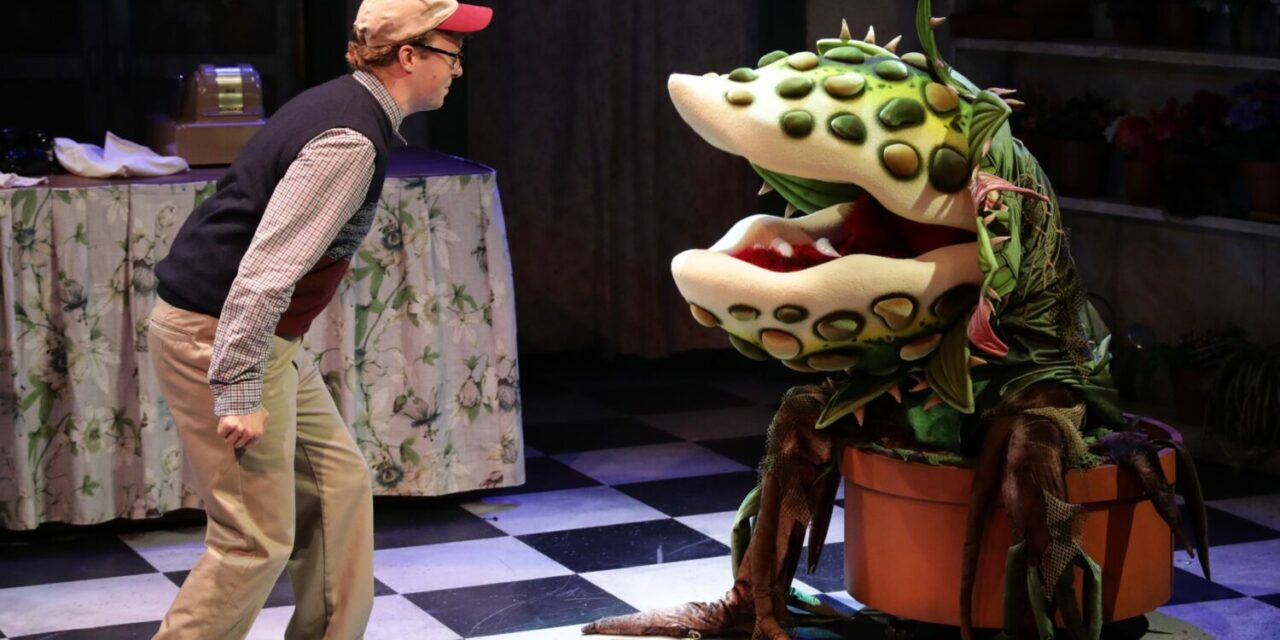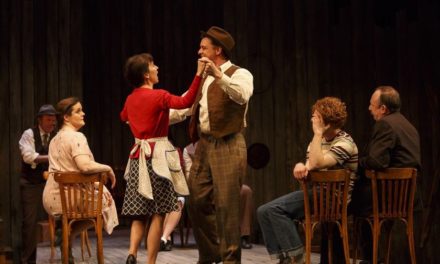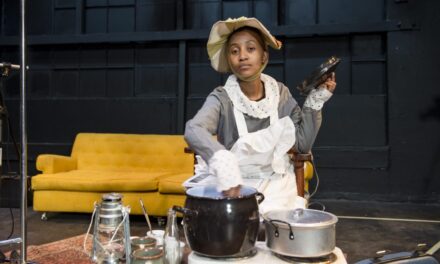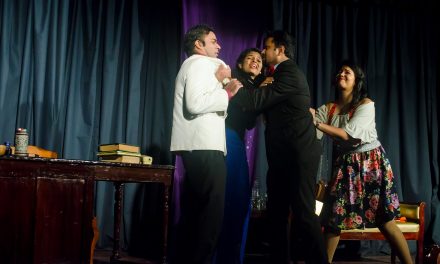When Audrey (Katrina Pavao) sings “Somewhere That’s Green” in Lyric Stage Company of Boston’s production of Little Shop of Horrors, she plaintively paints a picture of domestic life far removed from her current reality on Skid Row. And while crooning about a dream life settled with the mousy but sweet Seymour Krelborn, her lyrics brim with all manner of domestic conveniences and goods. In Audrey’s fantasy “tract house” she has a grill, a disposal, a washer and drier, furniture, and an “ironing machine.” An obvious irony in “Somewhere That’s Green” is that it would also take a lot of a different type of “green” to make such a life possible. Despite the cult musical’s plot about an extraterrestrial man-eating plant (spoiler alert), the musical dramaturgically reads as a criticism of capitalism, emphasizing poverty and inequality right from the opening song “Skid Row (Downtown).” Beyond the ravenous alien topiary, Alan Menken’s unforgettable score, and the black comedy that undergirds the work, this structural criticism in the musical may explain a recent resurgence of this work in Boston (Boston’s 2nd Stage theater will be performing it later this year) and across the globe. According to Music Theatre International’s website (the licensing organization for Little Shop of Horrors), about 200 productions of the musical are expected this 2019-2020 season in North America alone, including two notable upcoming productions in LA and New York City, both beginning previews Sept. 17th. The work has always been popular but there may be something in the air that has audiences and Audrey II chomping at the bit for more.
The Boston audience of Lyric Stage Company’s production seemed ravenous in their way, enjoying the production from the start. The theater company has cultivated a devoted audience during its 45 years in the city. Currently, Lyric Stage Company resides in a modest space, seating about 234 people, tucked inside the boutique Hotel 140. Under Artistic Director Spiro Veloudos, the theater has maintained a community of Boston performers, directors, and designers—one of the few local professional theaters to primarily cull from local talent—and an audience who loves them. This production of Little Shop of Horrors brought about the return of Director/Choreographer Rachel Bertone, who directed Kiss of the Spiderwoman for Lyric Stage last season, and, outside of Dan Prior as Seymour Krelborn and puppeteer Tim Hoover, almost the entire cast has trod the boards of Lyric Stage in previous seasons.
As a production, Director Bertone alongside Musical Director Dan Rodriguez consistently propels the absurdly fun energy of the piece forward. Almost all the singing is strong if not capable. Unfortunately, the sound quality is commonly rough in the small space—even more notable in their musical offerings. The band was placed behind the set, and sounded like it, while the un-miked singers sometimes found themselves drowned out from the band. The only miked performer is Yewande Odetoyinbo as the murderous plant Audrey II and she, at times, drowns out the other voices on stage. Nonetheless, the performers approach the roles with infectious energy and joy.
Lovely Hoffman, Carla Martinez, and Pier Lamia Porter portray the Greek chorus cum the Supremes, each distinctly different and impressive in their singing and performance. Dan Prior provides the necessary nerdy sweetness of Seymour, without making him fully impotent as a character while Boston favorite Remo Airaldi as Mr. Mushnick is combustible and utterly delightful. The two roles, which are skillfully played but saddled by the weight of the performances in the original production and movie are Audrey (played by Katrina Z Pavao) and Orin Scrivello, the sadistic dentist (Jeff Marcus).
One of the great challenges of reviving this specific musical is the iconic performances that endeared audiences to this property in the first place. The 1986 Frank Oz-directed movie musical had Ellen Greene reprise her off-Broadway performance as Audrey, endowing the character with an idiosyncratic unselfconscious New Jersey coquettishness, which has shaped Audrey for many productions to come. Similarly, the description of Orin Scrivello D.D.S., played in the film by Steve Martin, is a gleeful sadist, but Martin’s faux “leader of the pack” coolness has led to many imitators, and this production was no different. Both Katrina Pavao and Jeff Marcus give strong performances (Jeff Marcus having to play multiple characters throughout the piece) but the direction of the piece has them greatly confined to hybrid imitation/interpretations of the original performances. It does not help that this Audrey is designed to look quite similar to Ellen Greene’s Audrey, robed in tight animal prints and bewigged in blond locks (in a particularly cheap-looking wig in this production). Which, in the end, is the slight weakness of this production: it reads as Little Shop of Horrors through a xerox copy of a xerox copy of the production—vaguely like the original but not quite as clear or fresh.
When the upcoming flashy NY production of Little Shop was announced for the Westside Theatre earlier this year, there was a certain amount of buzz, especially around the cast of Jonathan Groff, Tammy Blanchard, and Christian Borle—all successful Broadway performers in their own right. Then the LA production was announced, boasting a younger, much more diverse cast: George Salazar, MJ Rodriguez, and Amber Riley. Suddenly, it seemed that, as exciting as the Broadway veterans were, the LA cast was exciting and progressive in its concept! Of course, time will tell if the direction of either production pushes this production forward in any way from the early 1980’s cult musical—itself culled from the 1960 Roger Corman cult film. For many years, productions have preserved the faux-fifties cult sensibility that informed Howard Ashman and Alan Menken’s musical. The leader of the pack biker dentist, the obsession with tract house suburbia, and Motown girl groups are all part and parcel of the era, and Ashman and Menken cleverly make great fun of the sensibility of that time. But some of those markers aren’t as legible to younger audiences and it is possibly high time to play with the tropes in different ways. For example, there is no clear reason that Audrey must be a busty blonde. A woman of any size, shape, and ethnicity could play the character because the only essential structural elements of the character are that she should be meekly charming and adored by the men in her life. The continuation of Ellen Greene’s portrayal indicates that, in the world of the reproductions of Little Shop of Horrors, “attractive” is only a specific body type, voice, hair, and ethnicity.
One essential element to the work that reads as evermore timely in modern revivals of Little Shop—such as the Lyric Stage production—is the work’s explicit criticism of American capitalism. Early in the musical, the song “Downtown” paints the picture of Skid Row as a place, “Where the folks are broke” and “Where life’s a joke.” In one of the song’s verses, Seymour laments that he’s “Poor! All my life, I’ve always been poor. I keep asking God what I’m for and he tells me, ‘Gee, I’m not sure…sweep the floor, kid.’” It is no wonder then, that when the alien plant becomes a media sensation, Seymour’s star begins to finally rise. This leads to Mr. Mushnik deceitfully adopting orphan Seymour to protect the financial future of the flower shop. Eventually, the fame and fortune that comes with the cultivation of Audrey II lead to the downfall of Mr. Mushnik, Audrey, and Seymour. While the pursuit of financial success, a nice home, and fame are nothing new, the era that birthed 1982 off-Broadway musical and the 1986 film have strong resonances to the economy and political moment of our day.
The Wall Street heyday of the early 1980s came on the heels of huge shifts in the financial sector and corporate culture. Milton Friedman’s 1970 New York Times Magazine article, which said that the only “social responsibility of business is to increase its profits” led to a reexamination of corporate responsibility towards shareholders, rather than stakeholders. Simply put, stakeholders were the customers who relied on a product or good, employees who made the products, and the society that was affected by the work of the organization. Shareholders were the people who had a financial stake in the success of the organization. Economists are still studying the effects of such a shift but one thing is clear from where we sit: CEO compensation since 1978 has ballooned 940% while the average American worker has only increased by 12% over that same period. Ronald Regan’s conservative presidency (1981-1989) encouraged deregulation that only further empowered huge gains on Wall Street and by corporations. As exemplified by Oliver Stone’s 1987 film Wall Street, financiers and traders were raking it in hand over fist, while proudly and loudly displaying their wealth. In that same year, Donald Trump’s Art of the Deal hit bookshelves. But after a Dow Jones that tripled between 1982-87, creating a windfall for investors, it all came crashing down in October of 1987, with a 22% Dow plunge in one day in what is now called “Black Monday.” But the CEO and worker pay divide continued unabated.
The economy remains one of the most important issues for voters (sometimes tying with healthcare in voter’s priorities) and there is a cogent argument that the election of Donald Trump, a noted “businessman” and celebrity, indicated that many Americans believed that he could improve the US economy. Strangely, it also heralds the arrival of the 1980s again, when another conservative celebrity held the White House. We see the resonances of a time that proclaimed greed to be good, while, for many, the “American Dream” has remained just that: a dream…despite the many years trying to pay for your own tract house.
One of the blessed differences of the film and stage musical of Little Shop of Horrors is the ending of the musical. In the movie, Audrey and Seymour marry and move into their suburban dreamscape, presumably replete with their grill, disposal, and ironing machine. In the stage production, there is no such joy. Patrick Martin (also played by Jeff Marcus here) from “World Botanical Enterprises” breaks into the flower shop and takes a few cuttings of the plant to sell, hoping that their popularity will be “bigger than Hula-Hoops.” In doing so, Patrick sets an apocalyptic course for the world, all predicated on his wish to sell, sell, sell. Narratively, we won’t ever know if Audrey II would take over the world on its own. It never needed to go on its own when unabated capitalism enabled it to grow and feed itself on mankind.
This post was written by the author in their personal capacity.The opinions expressed in this article are the author’s own and do not reflect the view of The Theatre Times, their staff or collaborators.
This post was written by James Montaño.
The views expressed here belong to the author and do not necessarily reflect our views and opinions.


















